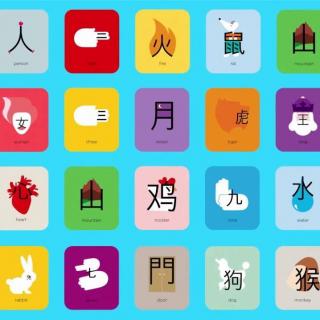
掌握汉语 竟能如此简单Breaking the language barrier could be child’s play
2017-08-04 04'26''
主播: FM1028192
392 14
介绍:
轻松学汉语(Chineasy)的创始人薛晓岚一直在尽其所能打破学习汉语的障碍。
Chineasy founder ShaoLan Hsueh is on a mission to break down the language barrier surrounding Chinese any way she can.
2014年,她着手编写的汉语教学书《Chineasy:The New Way to Read Chinese》在美国出版。书中用巧妙有趣的插图生动形象地展示了汉语近400个基本字义的意思(由她在伦敦带领的团队设计)。
She started with the book Chineasy: The New Way to Read Chinese, released in the US in 2014, which basically teaches the meaning of about 400 essential characters by encasing them in clever and often amusing illustrations (created by a team of artists at her headquarters in London).
书中,她拆分了每一个单字,并展示了如何将它们组成一个合字。例如:“好”,指一切美好的事物,配图上是一“女”与一“子”站在一起组成“好”字,意示母爱为善的意思。对于“吃”字,则是用一个正方形代表“口”,旁边用“屈膝”状的线条代表“乞”。
From there she dissects each one and reassembles it, demonstrating how the Chinese language is put together. Hao, the word for good, for instance, is a combination of the character for woman and boy, suggesting motherhood is a good thing. The term for eating is an open space representing a mouth and next to it the squiggle for begging.
薛晓岚相信汉语并没有人们所想的那么难学,她的目标是让初学者快速掌握1000多个基础字。她指出中国政府要求人们能够用1500字即可诵读新闻,不过大学生需要多掌握几千字。
ShaoLan is convinced that Chinese is a lot easier than most people think and her goal is to get beginners a basic knowledge of 1,000 or so characters quickly. She points out that the government in China requires that people should be able to read newspapers with just 1,500 characters, while university students need a few thousand.
她一直在不断的尝试,希望能通过“网络效应”引导学生学习汉语。“一两个简单字就能衍生出三四个合成字,掌握几十个就能知道几百个,掌握50到70个字就能认识上千个字。”她说。
She’s shooting for something in between and hoping the “network effect” will guide students from there. “Knowing one or two [characters] you can create three or four; knowing tens you can make hundreds; knowing 50 or 70 you can create thousands,” she said.
薛晓岚(Facebook的粉丝多达40万人)一直与世界各地的教育家和学生分享她的方法,并收集反馈和建议。她最新开发了一款名为Chineasy Tiles:Play to Learn Chinese的桌游。
She has been sharing her approach with educators and students the world over for years (to the tune of 400,000 followers on facebook), garnering feedback and suggestions and her latest tool is a board game called Chineasy Tiles: Play to Learn Chinese.
Chineasy团队带着样品走进麻省理工学院和其他学校,让数百名外国人试用这款玩具。
Chineasy Tiles里共有48张“基础字”卡片:雨,木,好,不,狗,白等等,其中一面是插图和英文单词,另一面是汉字释义和拼音。
Conceived after extensive testing of hundreds of groups of non-Chinese speakers by teams in London, at MIT and other classrooms around the world, the game uses 48 “essential character” tiles: rain, woods, good, not/no, dog, white, and so on, with their give-away illustration and English word on one side and the plain character with pin yin term on the back.
薛晓岚在YouTube视频教程中展示了“碎片式”的汉字是如何组建出简单的词组。“吃”和“大”组在一起表示“大吃(eat like a pig)”;“小”和“吃”组成“小吃(snake)”,也叫路边摊;“牛”遇到“水”就有了“水牛(buffalo)”。
In a youtube demonstration, ShaoLan demonstrates how easily rudimentary sentences can come together using the tiles as building blocks. Eat plus big means “eat like a pig”. Small plus eat means snack, or street food. Cow plus water means buffalo.
那么“no+eat+cow+meat……”,你就能知道它的意思了(“不吃牛肉”)。chineasy网站的明智之处就在于,它为不熟悉这门语言的人强调了“加号”的作用:没有语法,没有时态,没有性别区分,没有词语顺序的硬性规定。
No plus eat plus cow plus meat… you get the idea. But the brilliance of the Chineasy approach is that it emphasizes the pluses of the language for an outsider: there is no grammar, no tense, no “he or she” gender and no hard-and-fast ordering of words in a sentence.
Chineasy Tiles玩具盒中共有两副卡片和一张游戏板,其中一副是48张必识字卡,还有一袋小卡片。五行五列的游戏板则是用来玩Chineasy Bingo游戏。薛晓岚说现在全世界有1500名教师在研究这套卡片的新玩法。
The game set comes with a set of large tiles and a game board and a sack of smaller tiles with five-by-five racks for playing a version of Chineasy Bingo. ShaoLan said that 1,500 teachers worldwide are coming up with new games and ways to use the pieces.
薛晓岚说,当有人说Chineasy是“汉语版字母表”的时候,她特别高兴。
ShaoLan said she is flattered that some people have been calling Chineseasy “the alphabet of Chinese.”
“
但任重而道远,”她说,“我们没有完全覆盖20万个汉字,只想让学生快速掌握几千个基础汉字后培养基本的识字能力。”
“But we’re not there yet,” she said. “We don’t cover all 200,000 characters, just aim for a very basic literacy by knowing a few thousand quickly.
上一期: 现实是真实存在的吗?Could life really be just a simulation?
下一期: 禁止比伯来华演出为中国立场点赞 Kudos for China's stand on Bieber
下一期: 禁止比伯来华演出为中国立场点赞 Kudos for China's stand on Bieber
大家还在听

